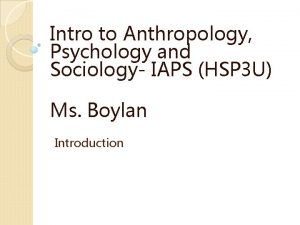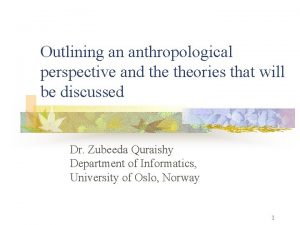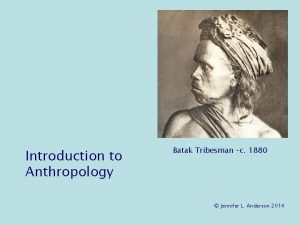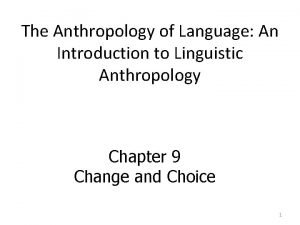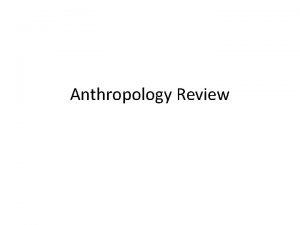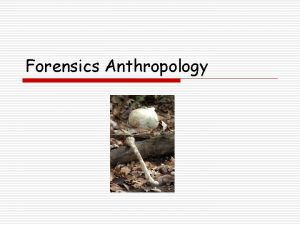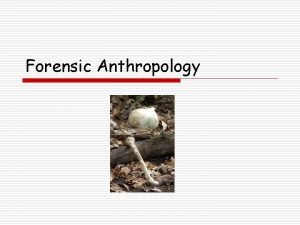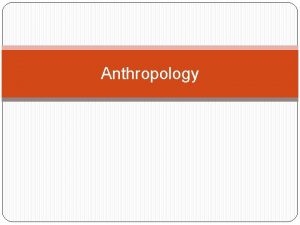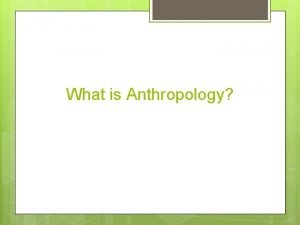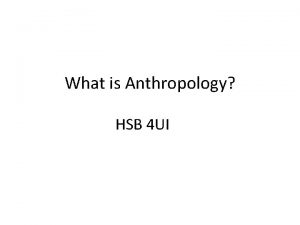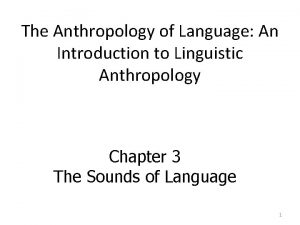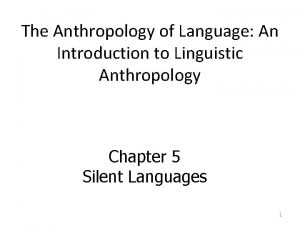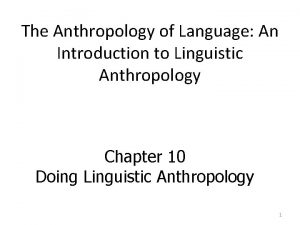The Anthropology of Language An Introduction to Linguistic
























- Slides: 24

The Anthropology of Language: An Introduction to Linguistic Anthropology Chapter 2 Language and Culture 1

Culture • In 1952, a couple of fairly famous anthropologists, Alfred Kroeber (father of Ursula K. Le Guin) and Clyde Kluckhohn, published a book containing 164 definitions of culture taken from the published work of anthropologists. Fifty-seven years later, we are still not all agreed on the topic. • One widely used definition (thanks to Max Weber and Clifford Geertz): Culture is a web of meaning which human beings weave and in which we are suspended. 2

The emic vs. etic distinction • Two equally valid perspectives from which to view human behavior, activities, values, etc. • Emic—subjectively relevant, internally verifiable • Etic—objectively identifiable, externally observable 3

Etic and Emic – an example • Etic data—things that are observable – 110° F water into mug, water swirled in mug, water poured into the sink, drink poured into mug • Emic data—the meaning of the action for the actor – He warms his coffee mug so that the coffee tastes better » Or – She tries to kill all the germs and bacteria that have accumulated in the coffee mug since its last washing 4

Ethnosemantics • 1950 s and 60 s • Frake, Goodenough, Conklin • Alternate names: – Ethnoscience, Cognitive Anthropology • Vocabulary indicates – “native” categories – Culturally important distinctions • Psychological reality or formal account? 5

Cultural emphases – What IS subjectively relevant? • Cultural emphases reflect activities, meet needs • Some universal patterns appear to exist, however • Color terms – Stages 1 -7 (Ottenheimer p. 31) • Color terms and focal points (Berlin & Kay) – Codability—how easy is it to name a color chip – Availability—how easy is it to find a given chip in a group of other chips 6

The Hanunóo case • You cannot ask, in Hanunóo, “What color is X? ” • Hanunóo are able to distinguish colors (human biological ability), but color is subsumed within an overall category of appearance. • Ethnosemantic research was required to understand how Hanunóo speakers communicate the idea of color. 7

Getting at the Emic – Doing ethnosemantic research • Creating a taxonomy – Asking questions about relationships: • Is X a kind of Y? • What other kinds of Y are there? • Are there other kinds of X? – Taxonomy about relationships • Componential analysis – Discovering key differences 8

Sapir-Whorf or Whorfian hypothesis: two versions • Strong Whorf—language determines thought, you think within the structure of your language – Agar—language as prison • Weaker Whorf—language provides habitual patterns of seeing, thinking and talking – Agar—Language as a familiar room; you know where everything is in it • Both forms of linguistic determinism 9

Which comes first? A chicken and egg problem. • Nature of cultural emphasis – Feature analysis – Prototype theory • Color categories and the search for universals – Human shared sensory apparatus – Impact of language • Agreement about differences between languages • But, do the differences in language reflect cultural differences, or create cultural differences? 10

Linguistic Determinism • Origins – “Human beings. . . are very much at the mercy of the particular language which has become the medium of expression for their society. ” (Sapir 1929) – “we cannot talk at all except by subscribing to the organization and classification of data” (Whorf 1940) 11

Examples of Linguistic Determinism: SAE • time = matter • units of time = objects • passage of time = endless line of identical objects 12

Examples of Linguistic Determinism: Hopi • time = a process • units of time = cycles • passage of time = endless repetition of same cycle 13

Testing linguistic determinism • Tests generally comparative • Variable clearly identified • Testing availability and codability 14

Experiments in Linguistic Determinism • Yucatec – Grammar stresses material • Connects words for wood, tree, table – Individuals group cardboard items together • English – Grammar stresses shape • Different words for wood, tree, table – Individuals group boxes together 15

Further Evidence for Linguistic Determinism • Relative space vs. absolute space – Guugu-Yimidhirr • NORTH-SOUTH-EAST-WEST (absolute) – Tzeltal • UPHILL-DOWNHILL (relative) 16

Experiencing Linguistic Determinism • Temporary transfer of control – English—lend/borrow – Shinzwani—kopa • Telling time – English—it is half past nine – Czech—it is half of ten • Relative vs. absolute space – English—deictic system – Guugu-Yimidhirr—absolute system 17

Experience and imagination • Metaphor—a figure of speech in which a term or phrase is applied to something to which it is not literally applicable in order to suggest a resemblance • Metonymy—a figure of speech that consists of the use of the name of one object or concept for that of another to which it is related, or of which it is a part • Frame—a system of expectations which influences experience 18

Metaphors in SAE – a set of examples • Anger as Body heat – I have a hot temper. • Body as container of emotions – I am just about up to here! – He was filled with grief. • Body as container for emotions plus Anger as heat = – Heating fluid in a container • He was boiling mad. • She was fuming. • I was steamed. – Dealt with by cooling or containing • A good workout always helps her cool her temper. • I keep my anger bottled up. – Potential for explosion, in which things go up • I blew my top. • She hit the ceiling. • He went right through the roof. 19

Metonyms in SAE – some examples • Friends, Romans, countrymen, lend me your ears. • Yesterday, the White House announced… • Wall Street reacted badly to the news from Europe. • My knee is killing me. • If you like it then you should-a put a ring on it. 20

Frames – structures of expectation we use to make sense of the world • Frames make use of, and make sense of, metaphors and metonyms • Frames trump facts (Lakoff); they make it difficult to absorb things that don’t fit • Examples: – The restaurant – The classroom • Practices, not things – Shifting frames—the Cousin Joe example – Shifting frames—the club meeting 21

The significance of frames • “gay marriage” or “same-sex marriage” • “looting” or “finding” • “the rich” or “job creators” • “quiz” or “assessment” • “date” or “hook-up” 22

Coping with differences • Using the one you are in is easier than trying to translate concepts • Translation, if it requires completely identical meanings, is frequently not possible • The system you are in will shape your perceptions, however • Human beings construct the systems of meaning which shape our perceptions • You are ALWAYS in a system of meaning, but you are not trapped in any particular system of meaning 23

Summary • Language is a window into culture (Boas) • Language is a cultural map (Conklin, Frake…) • Language is a guide to social reality (Sapir/Whorf) – Linguistic relativity: grammar influences thought • A well-accepted idea – Linguistic determinism: grammar determines world view • Still controversial • Language is a framing device (Lakoff) – Helps us to organize and frame our experience of the world – And to express our experience of the world 24
 Linguistic anthropology example
Linguistic anthropology example Anthropology psychology and sociology
Anthropology psychology and sociology Venn diagram of psychology and sociology
Venn diagram of psychology and sociology Introduction to anthropology psychology and sociology
Introduction to anthropology psychology and sociology Example of anthropology perspective
Example of anthropology perspective Introduction to anthropology
Introduction to anthropology The anthropology of language
The anthropology of language Hát kết hợp bộ gõ cơ thể
Hát kết hợp bộ gõ cơ thể Ng-html
Ng-html Bổ thể
Bổ thể Tỉ lệ cơ thể trẻ em
Tỉ lệ cơ thể trẻ em Chó sói
Chó sói Glasgow thang điểm
Glasgow thang điểm Hát lên người ơi alleluia
Hát lên người ơi alleluia Môn thể thao bắt đầu bằng chữ đua
Môn thể thao bắt đầu bằng chữ đua Thế nào là hệ số cao nhất
Thế nào là hệ số cao nhất Các châu lục và đại dương trên thế giới
Các châu lục và đại dương trên thế giới Công của trọng lực
Công của trọng lực Trời xanh đây là của chúng ta thể thơ
Trời xanh đây là của chúng ta thể thơ Mật thư tọa độ 5x5
Mật thư tọa độ 5x5 Làm thế nào để 102-1=99
Làm thế nào để 102-1=99 Phản ứng thế ankan
Phản ứng thế ankan Các châu lục và đại dương trên thế giới
Các châu lục và đại dương trên thế giới Thơ thất ngôn tứ tuyệt đường luật
Thơ thất ngôn tứ tuyệt đường luật Quá trình desamine hóa có thể tạo ra
Quá trình desamine hóa có thể tạo ra

